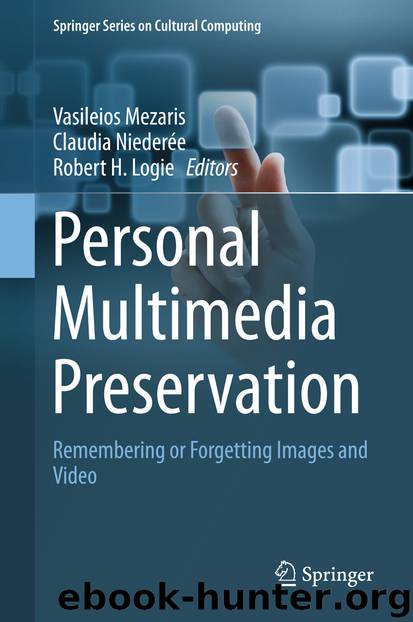Personal Multimedia Preservation by Vasileios Mezaris Claudia Niederée & Robert H. Logie

Author:Vasileios Mezaris, Claudia Niederée & Robert H. Logie
Language: eng
Format: epub
Publisher: Springer International Publishing, Cham
An overview of this method is illustrated in Fig. 5.14. This method takes as input a photo collection that has been captured by a user attending an event and a textual description of the event that contains the name, location and time of the event. Web photos that are related to the event are retrieved and downloaded, their visual content is analysed and a selection of them is provided to the user as additional contextual content.
First, the user’s photo collection is fed into an image analysis component. Using the Caffe framework [181] and the 22-layer GoogLeNet Deep Convolutional Neural Network (DCNN) pre-trained model [377], the loss1/classifier and loss3/classifier layers’ output is extracted (resulting in two 1000-dimensional vectors). The L*a*b* colourspace colour histogram of each photo is also calculated, using 8 bins for the L* plane, 32 bins for the a* plane and 32 bins for the b* plane (resulting in a 72-dimensional vector). The 2072-dimensional concatenated feature vector of the DCNN layers output and the L*a*b* histogram are used to represent each photo in the user collection. The textual description that must be provided by the user consists of the name of the event (e.g. Olympic Games), the location (e.g. London) where the event took place and the date that the event took place (e.g. 2012). This information is then used to create a set of queries which are sent to web search engines, and a pool of data is collected, from which the contextual information will be selected. The following three web queries are performed:1.A query to the Google text search engine; the P first web pages and the Y first YouTube links of the search results are kept. Moreover, the photos contained in the returned web pages are also collected. The query to the Google text search engine is formed by combining the textual description provided by the user, using AND (&) (i.e. event & location & time).
Download
This site does not store any files on its server. We only index and link to content provided by other sites. Please contact the content providers to delete copyright contents if any and email us, we'll remove relevant links or contents immediately.
Algorithms of the Intelligent Web by Haralambos Marmanis;Dmitry Babenko(8522)
Test-Driven Development with Java by Alan Mellor(7427)
Data Augmentation with Python by Duc Haba(7317)
Principles of Data Fabric by Sonia Mezzetta(7065)
Learn Blender Simulations the Right Way by Stephen Pearson(7006)
Microservices with Spring Boot 3 and Spring Cloud by Magnus Larsson(6825)
RPA Solution Architect's Handbook by Sachin Sahgal(6234)
Hadoop in Practice by Alex Holmes(6032)
The Infinite Retina by Robert Scoble Irena Cronin(5935)
Jquery UI in Action : Master the concepts Of Jquery UI: A Step By Step Approach by ANMOL GOYAL(5873)
Big Data Analysis with Python by Ivan Marin(5732)
Life 3.0: Being Human in the Age of Artificial Intelligence by Tegmark Max(5404)
Pretrain Vision and Large Language Models in Python by Emily Webber(4693)
Infrastructure as Code for Beginners by Russ McKendrick(4471)
WordPress Plugin Development Cookbook by Yannick Lefebvre(4204)
Functional Programming in JavaScript by Mantyla Dan(4124)
The Age of Surveillance Capitalism by Shoshana Zuboff(4117)
Embracing Microservices Design by Ovais Mehboob Ahmed Khan Nabil Siddiqui and Timothy Oleson(3995)
Applied Machine Learning for Healthcare and Life Sciences Using AWS by Ujjwal Ratan(3971)
